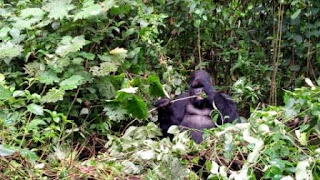Ben in the middle of Bugoma Forest
On 6th of August, I embarked on my first trip to Bugoma. Under the tutelage of Destination Jungle tours as a trainee and photographer, I was excited about the whole trip even before setting foot. Bugoma is located in Hoima District. Known for its Forest that has called for a lot of conservation campaigns. For instance, the campaign for tree planting that is under the Association for the Conservation of Bugoma Forest (ACBF). However, Bugoma is also well known for its Mangabeys. Mangabeys are one of the rare species of primates-monkeys. This species is rare and can majorly be found in Bugoma Forest.
Having to
track an animal, and capture it in pictures is one of the most exciting thing
in photography because it calls for uncertainty and alertness before testing your patience. Our trip started
from 2Friends Hotel in Entebbe from where we had to pick our Spanish guests.
And by 9am, we were already on the Express Highway headed for our Panorama
Safari Trip. We went through Masindi, visiting Ziwa Rhino sanctuary where we
had lunch and our guests were already excited about their first tracking
experience, and lucky to have seen a family of white rhinos in the ponded clay
muddy rhino sanctuary.
Then next
on agenda, we further headed towards the North West part of Uganda, towards
Masindi. We arrived at Murchison Falls towards the sunset hours. These hours
are always my favorite because of the golden yellow sunrays that add beauty and
flattery to photos. It was amazing. We spent the night at Bamboo Village lodge.
Where, together with the senior tour guide, our guests had their first morning
game drive in Murchison Falls National Park. We spent two days in Murchison
Falls. And headed for Bugoma, pushing further towards Hoima District, located
in the northwestern part of Uganda.
I immediately started taking pictures of the surroundings as I waited for the evening community walk in the local homesteads situated on the verges of Bugoma Forest, in anticipation that I could be lucky enough to lay sight on the mangabeys, the proverbial elusive primates. We had our walk in the evening, with a group of other Spanish guests, through Bugoma Forest under the guidance of a group of trained ACBF guides. These guys are competent, their intelligibility while elaborating on the ACBF projects notably, the ACBF bee project and the banana beer project denoted of experience. I also had an opportunity to learn some things about the forest, the oldest trees plus other trees and their medicinal virtues.
ACBF guide elaborating to the guests
We walked through the forest, having occasional stops to listen to the guides’ elaborations. And then we reached in the local communities before I could see any trace of the mangabeys. It was exquisite and authentic. The homesteads and the lifestyle of the local people denoted of the typical Ugandan homestead, grass-thatched houses constructed from reeds and baked dark brown soil. I was happy to see authenticity in its full form, seeing these kids playing soccer, barefoot, with a ball made out of banana fibers. It got more exciting when one guest chose to have a moment of playing some soccer with the local kids. Nothing is more compelling and brings more frenzy like a photographer standing in front of authenticity. That was day one. No mangabeys in sight. Unfortunately!
Guests during the community walk in Bugoma
I made
other two walks for the next day and always the same story. No mangabeys that
morning.
And finally, the next morning attempt yielded. The mangabeys showed up, crossing over through the branches in the tallest trees of Bugoma Forest. Those animals are quite elusive sometimes. This was my third day of tracking mangabeys and the efforts finally paid off. I had my camera already strapped around my neck, zooming in for a close up and trying to catch the running mangabeys in the right frame. Their ululations could be heard as they ran across branches. It is always a challenge to take a shot of a moving subject, and with these elusive primates, I had to struggle through, adjusting the focal length and aperture priority, with frustration and looking for a clearer shot. It was the only chance I had to have these photos taken. They were hardly visible as they tended to hide behind branches but still their sounds betrayed their presence. I pressed on waiting, as Nazario (The ACBF local guide) repeated to the guests – The mangabeys are here!
Close-up of the mangabey in the highest branches of Bugoma Forest
It seemed to be a long shot, as they sometimes
kept running back and forth. They were far high up. I zoomed in to the maximum
of my camera lens, looking for focus until finally, one of them was clear in my
view. Admittedly this was also my first time to see a mangabey. And there I
was, having it in the focus of my camera. I somehow first failed to take any
shot, and watched it. It seemed to be looking directly in my lens, like it was
ready for the picture. And before it thought of jumping off to the next branch,
I pressed the shutter and ceaselessly some multiple shots. And just like the
guests, I had my first mangabey experience.
All in all,
I would not think twice to repeat the adventure. And I’d strongly recommend the
experience to whoever is adventurous. Because with adventure, there’s so much
patience to learn.






































